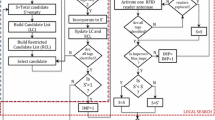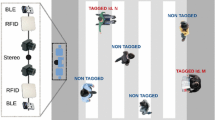Abstract
With the advent of the Internet of Things (IoT) and ubiquitous presence of sensor nodes, positioning technologies have become a topic of interest among researchers. While the applications of positioning systems are very vast, determining the position of moving sensor nodes, finding missing people in large areas, and object tracking are among the most popular ones. The focus of this paper is to propose a positioning system to locate missing people in theme parks. Currently, radio frequency identification (RFID) systems are used in modern theme parks to locate lost visitors. In these systems, a wristband with active RFID tag is given to each visitor and RFID readers are deployed in predetermined locations. When a visitor is in the communication range of a reader, its location can be estimated based on the location of the reader. Therefore, the accuracy of these systems is relevant to the communication range of readers. Another limitation of RFID-based systems is due to the fact that readers cannot be placed in communication range of each other as they can interference with each other. It is clear that the only way to increase the accuracy of such systems is by increasing the number of readers and decreasing the communication range of each reader. In this paper, a Bluetooth low energy (BLE)-based system is proposed to be used in theme parks for locating lost visitors. The advantage of using BLE is due to the fact that it uses frequency hopping spread spectrum (FHSS) thus readers can be placed in communication range of each other without severe interference. In the proposed method, at first, the optimal places for deploying readers are obtained using ant colony optimization (ACO). Then, a fuzzy approach is used to increase the accuracy of the system. Three different signal levels are defined to be used in our fuzzy system based on which the location of visitors can be estimated. By using three levels of signal strength, the accuracy of the system is increased compared with the similar system with the similar number of readers. The simulation results show that the accuracy of the system is improved using this method, and the cost of the system is decreased as BLE readers are much less expensive than their RFID counterparts.


















Similar content being viewed by others
References
Pearce P (1988) The ulysses Factor: Evaluating visitors in tourist settings. Springer-Verlag, New York
Bigné JE, Andreu L, Gnoth J (2005) The theme park experience: An analysis of pleasure, arousal and satisfaction. Tour Manag 26(6):833–844
Aldebert B, Dang RJ, Longhi C (2011) Innovation in the tourism industry: The case of Tourism@. Tour Manag 32(5):1204–1213
Tsai CY, Chang HT, Kuo RJ (2017) An ant colony based optimization for RFID reader deployment in theme parks under service level consideration. Tour Manag 58:1–14
Dong P, Siu NYM (2013) Servicescape elements, customer predispositions and service experience: The case of theme park visitors. Tour Manag 36:541–551
Oztekin A, Pajouh FM, Delen D, Swim LK (2010) An RFID network design methodology for asset tracking in healthcare. Decis Support Syst 49(1):100–109
Laguna M, Roa JO, Jiménez AR, Seco F (2009) Diversified local search for the optimal layout of beacons in an indoor positioning system. IIE Trans 41(3):247–259
Chen H, Zhu Y, Hu K, Ku T (2011) RFID network planning using a multi-swarm optimizer. J Netw Comput Appl 34(3):888–901
Chen H, Zhu Y, Hu K (2010) Multi-colony bacteria foraging optimization with cell-to-cell communication for RFID network planning. Appl Soft Comput 10(2):539–547
Bahl P, Padmanabhan VN (2000) RADAR: an in-building RF-based user location and tracking system. In: Proceedings of Nineteenth Annual Joint Conference of the IEEE Computer and Communications Societies, 26–30 March 2000
Ji M, Kim J, Jeon J, Cho Y (2015) Analysis of positioning accuracy corresponding to the number of BLE beacons in indoor positioning system. In: 2015 17th International Conference on Advanced Communication Technology (ICACT), IEEE, pp 92–95
Harter A, Hopper A (1994) A distributed location system for the active office. IEEE Netw 8(1):62–70
Priyantha NB, Chakraborty A, Balakrishnan H (2000) The cricket location-support system. In: Proceedings of the 6th annual international conference on Mobile computing and networking, pp 32–43
Gupta A, Harit V (2016) Child Safety & Tracking Management System by Using GPS, Geo-Fencing & Android Application: An Analysis. In: 2016 Second International Conference on Computational Intelligence & Communication Technology (CICT), IEEE, pp 683–686
Velayutham R, Sabari M, Rajeswari MS (2016) An innovative approach for women and children's security based location tracking system. In: 2016 International Conference on Circuit, Power and Computing Technologies (ICCPCT), IEEE, pp 1–5
Rezazadeh J, Subramanian R, Sandrasegaran K, Kong X, Moradi M, Khodamoradi F (2018) Novel iBeacon placement for indoor positioning in IoT. IEEE Sens J 18(24):10240–10247
Ni LM, Liu Y, Lau YC, Patil AP (2003) LANDMARC: indoor location sensing using active RFID. In: Proceedings of the First IEEE International Conference on Pervasive Computing and Communications, pp 407–415
Guan Q, Liu Y, Yang Y, Yu W (2006) Genetic approach for network planning in the RFID systems. In Sixth International Conference on Intelligent Systems Design and Applications, IEEE, vol 2, pp 567–572
Lin X, Lu R, Kwan D, Shen XS (2010) REACT: An RFID-based privacy-preserving children tracking scheme for large amusement parks. Comput Netw 54(15):2744–2755
Huang HP, Chang YT (2011) Optimal layout and deployment for RFID systems. Adv Eng Inform 25(1):4–10
Luo X, Obrien WJ, Julien CL (2011) Comparative evaluation of Received Signal-Strength Index (RSSI) based indoor localization techniques for construction jobsites. Adv Eng Inf 25(2):355–363
Zhou J, Shi J (2009) Localisation of stationary objects using passive RFID technology. Int J Comput Integr Manuf 22(7):717–726
Yin F, Zhao Y, Gunnarsson F, Gustafsson F (2017) Received-signal-strength threshold optimization using Gaussian processes. IEEE Trans Signal Process 65(8):2164–2177
He W, Ho PH, Tapolcai J (2017) Beacon deployment for unambiguous positioning. IEEE Internet Things J 4(5):1370–1379
Pang Y, Ding H, Liu J, Fang Y, Chen S (2018) A UHF RFID-based system for children tracking. IEEE Internet Things J 5(6):5055–5064
Andersen JB, Rappaport TS, Yoshida S (1995) Propagation Measurements and Models. In: IEEE Communications magazine, p. 43
Zhang P (2010) Advanced industrial control technology. William Andrew, Norwich
Sudholt D, Thyssen C (2012) Running time analysis of ant colony optimization for shortest path problems. J Discrete Algorithms 10:165–180
Dorigo M, Gambardella LM (1997) Ant colony system: a cooperative learning approach to the traveling salesman problem. IEEE Trans Evol Comput 1(1):53–66
Author information
Authors and Affiliations
Corresponding author
Additional information
Publisher's Note
Springer Nature remains neutral with regard to jurisdictional claims in published maps and institutional affiliations.
Rights and permissions
About this article
Cite this article
Einavipour, S., Javidan, R. An intelligent IoT-based positioning system for theme parks. J Supercomput 77, 9879–9904 (2021). https://doi.org/10.1007/s11227-021-03669-9
Accepted:
Published:
Issue Date:
DOI: https://doi.org/10.1007/s11227-021-03669-9




